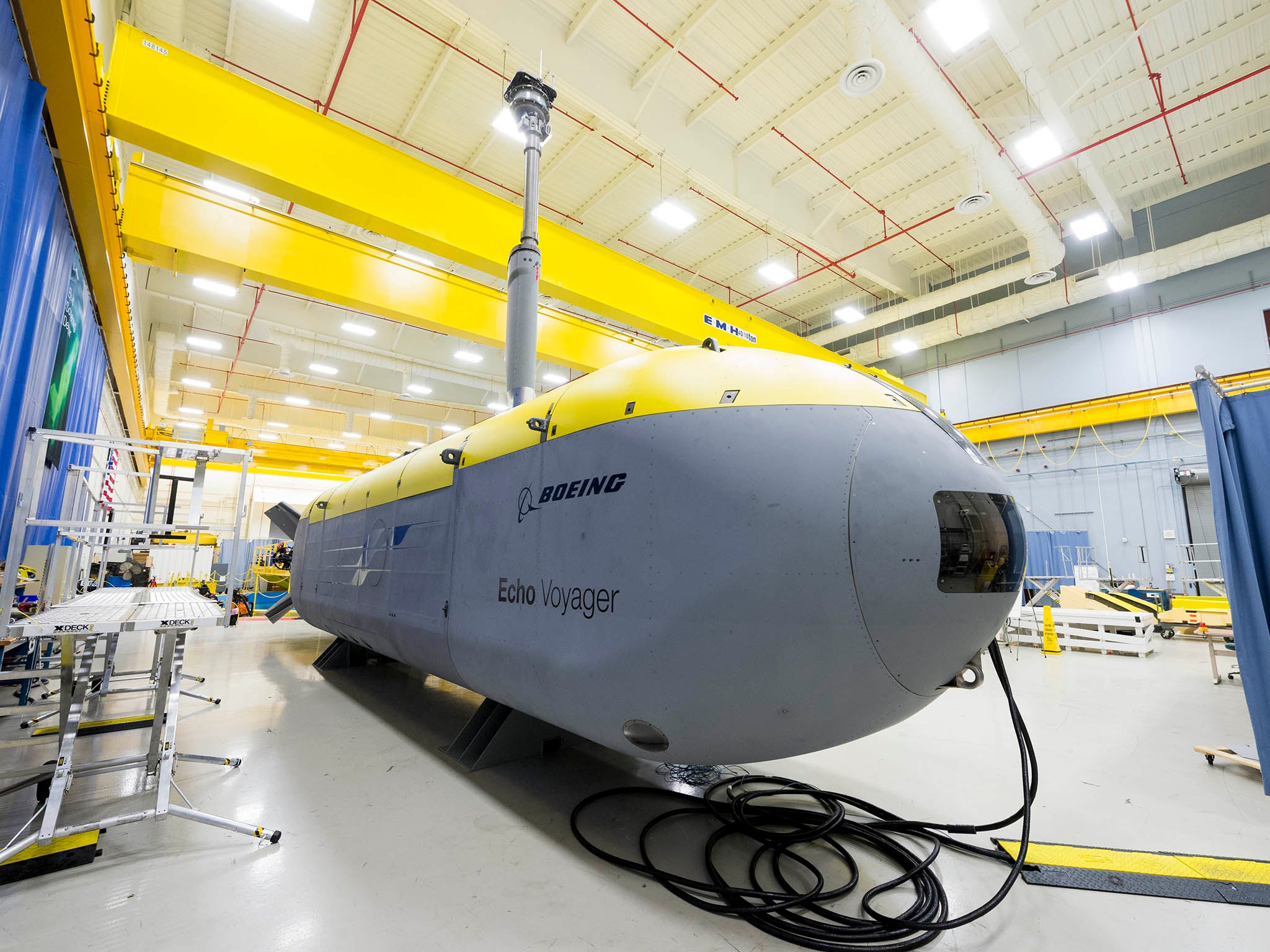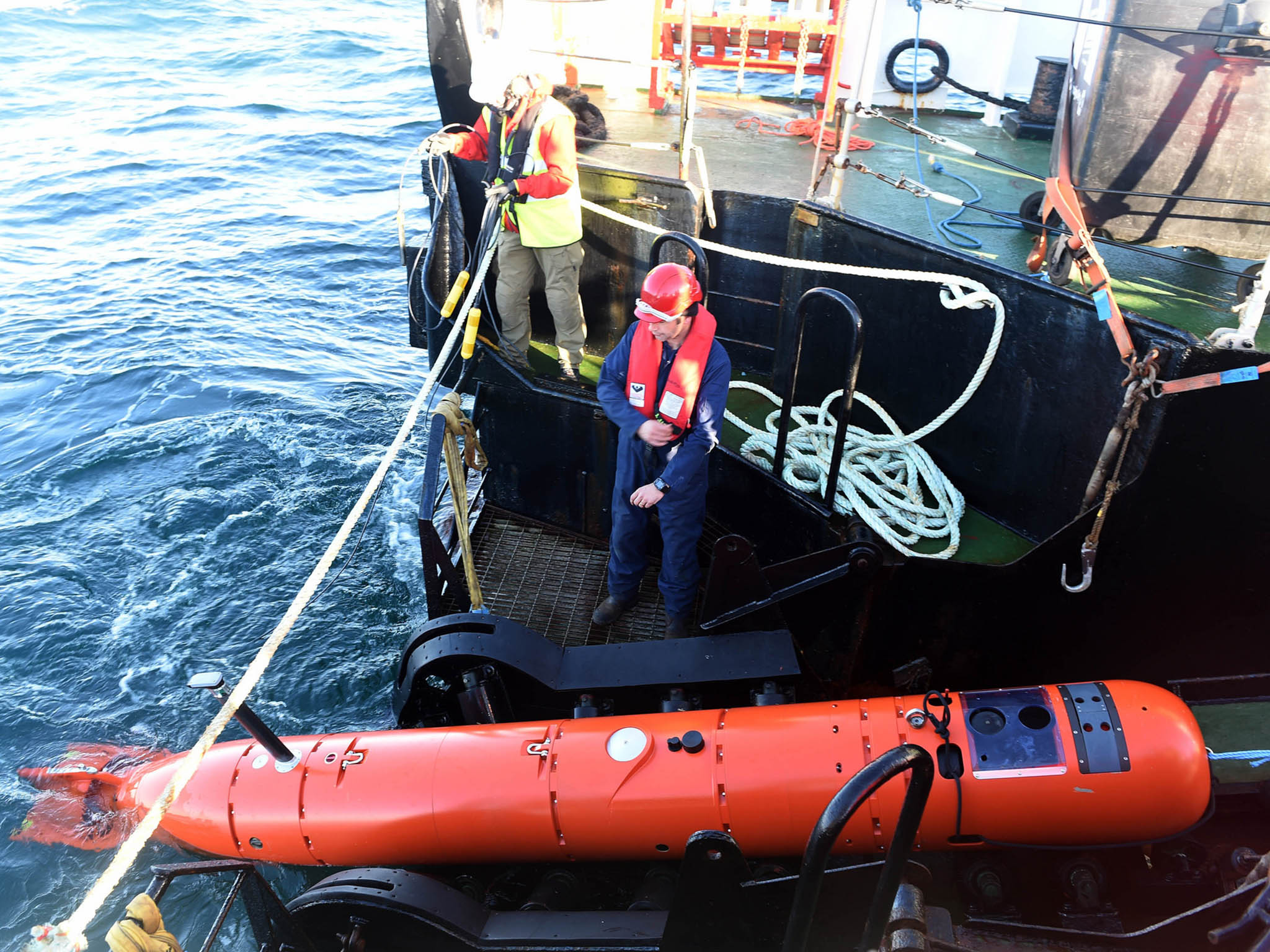Drone warfare heads underwater as US seeks advantage over rivals
The use of robots in war has caused controversy in recent years, and while they have reaped devastation on land, similar technology could be about to control the world’s waters

As unmanned aerial drones have become a critical part of modern warfare, the Pentagon is now looking to deploy autonomous robots underwater, patrolling the sea floor on what one top US navy official called an “Eisenhower highway network”, complete with rest stops where the drones could recharge.
Although still in the development stages, the technology has matured in recent years to be able to overcome the vast difficulties of operating underwater, a far harsher environment than what aerial drones face in the sky.
Saltwater corrodes metal. Water pressure can be crushing at great depths. And communication is severely limited, so the vehicles must be able to navigate on their own without being remotely piloted.
Despite the immense difficulties, the US navy has been testing and fielding several new systems designed to map the ocean floor, seek out mines, search for submarines and even launch attacks. While the unmanned crafts are now able to stay out for days or weeks, the goal is to create an underwater network of service stations that would allow the vehicles to do their jobs for months – and eventually years.
US military officials say there is a sense of urgency because the undersea domain, while often overlooked, could one day be as contested as the surface of the sea, the skies – and even space.
While Russia and China are investing in their submarine fleets, the Pentagon has sought to seize an advantage by introducing new technologies, especially those where humans team up with highly capable robots and autonomous systems.
In 2015, the US navy appointed its first deputy assistant secretary for unmanned systems. And the Pentagon plans to invest as much as $3bn (£2.4bn) in undersea systems in the coming years.
Last month, the US navy participated in the multi-nation Unmanned Warrior exercise off the coast of Scotland. Autonomous subs worked in concert with aerial drones to pass along intelligence that could be relayed from undersea to the air and then to troops on the ground.
It's too early to tell how the Trump administration might view the plans. But Bryan Clark, a senior fellow at the Centre for Strategic and Budgetary Assessments, said advancements in undersea warfare should continue to be a priority for the US navy.

“The Pentagon feels like the US is well positioned to do undersea warfare and anti-submarine warfare better than any other country,” said Clark, the author of a report titled The Emerging Era in Undersea Warfare. “What’s changing, though, is other countries are developing the ability to deny above the water. So the US is thinking it’ll have to rely much more on under the water.”
The goal is to have the unmanned underwater vehicles (UUVs) deploy from manned submarines or even large autonomous drone subs the way fighter jets take off from aircraft carriers, he said. The Chinese and others have built sensors that can detect large manned submarines, but the US military could still send in small, hard-to-detect drone subs.
The Office of Naval Research (ONR), which looks to develop advanced technologies, is seeking to “build the Eisenhower highway network on the seabeds in the seven oceans”, Rear Admiral Mathias Winter, head of the office, said at a conference this year. The ultimate goal is to “have large-scale deployments of UUVs”, he said. “We want them to go out for decades at a time.”
While the project is still in the conceptual stages, the US navy would one day like to build service stations underwater, similar to highway rest stops. There is even a name for them: forward-deployed energy and communications outposts.
“A place where you can gas up or charge your underwater vehicles, transfer data and maybe store some data,” said Frank Herr, the head of the ONR's Ocean Battlespace Sensing department.
While that may be a long way off, the Pentagon is testing vehicles that are capable of going out for weeks or even months at a time. In recent years, Boeing has developed the Echo Ranger and Echo Seeker, autonomous vehicles capable of carrying out days-long operations. This year, it debuted the Echo Voyager, a 51ft-long autonomous submarine with the ability to stay out for months; it isn’t dependent on a support ship the way others are.
This year, defence company General Dynamics boosted its underwater offerings when it acquired Bluefin Robotics, which makes several types of underwater robots. Its 16ft-long Bluefin-21 vehicle is capable of launching what the company calls “micro UUVs”, known as SandSharks, that weigh only about 15 pounds. The SandSharks could scan an enemy shoreline and pop up to the surface to relay data to aircraft flying overhead. The Bluefin-21 could even launch a tube that goes to the surface, sticks up like a large straw and then shoots out an unmanned aerial vehicle like a spitball.
While there are still huge hurdles to overcome, especially when it comes to battery life, underwater-vehicle technology is about where drone technology for aircraft was in the 1990s, said Carlo Zaffanella, General Dynamics’ vice president and general manager for maritime and strategic systems.
Signal processing is improving. So is autonomy, Zaffanella said. And the advancements are coming “at a time when underwater warfare is becoming more important”.
The Defence Advanced Research Projects Agency has a plan to plant 15ft-tall pods across the ocean floor that could sit there for years waiting to be awakened. When they received a signal, they would float to the surface and release aerial drones, which could perform surveillance over shorelines.
Defence contractor Raytheon, meanwhile, is working on a torpedo that instead of blowing things up would be the US military’s eyes and ears underwater, scouting for mines or enemy submarines, mapping the ocean floor and measuring currents.
The new generation of undersea vehicles would require powerful computer brains.
“The undersea environment is particularly challenging and unpredictable,” US navy Rear Admiral Bill Merz said at a recent conference. “I would even go out on a limb here to say we are truly the unmanned of the unmanned vehicles, and in most cases we don’t even have a man in the loop. So what we field and put in the water is on its own until we hear from it again.”
© The Washington Post
Join our commenting forum
Join thought-provoking conversations, follow other Independent readers and see their replies
Comments
Bookmark popover
Removed from bookmarks